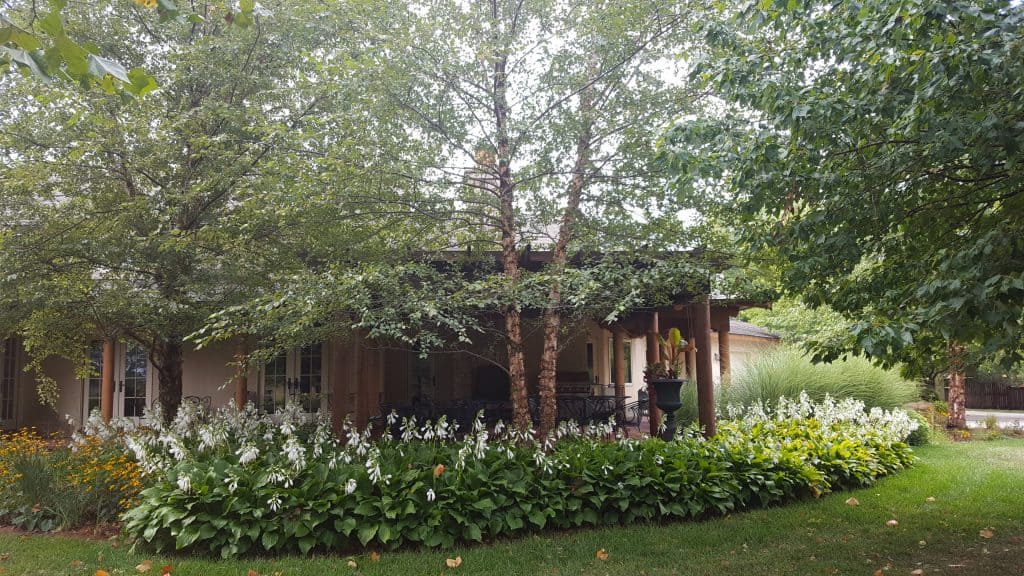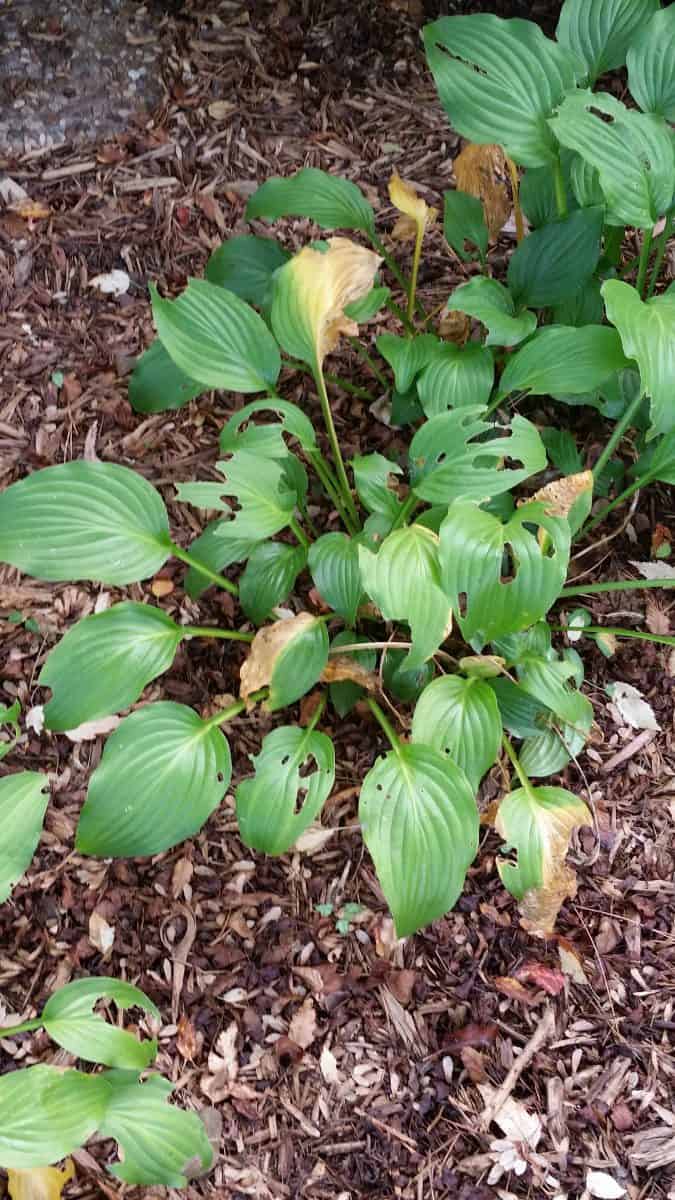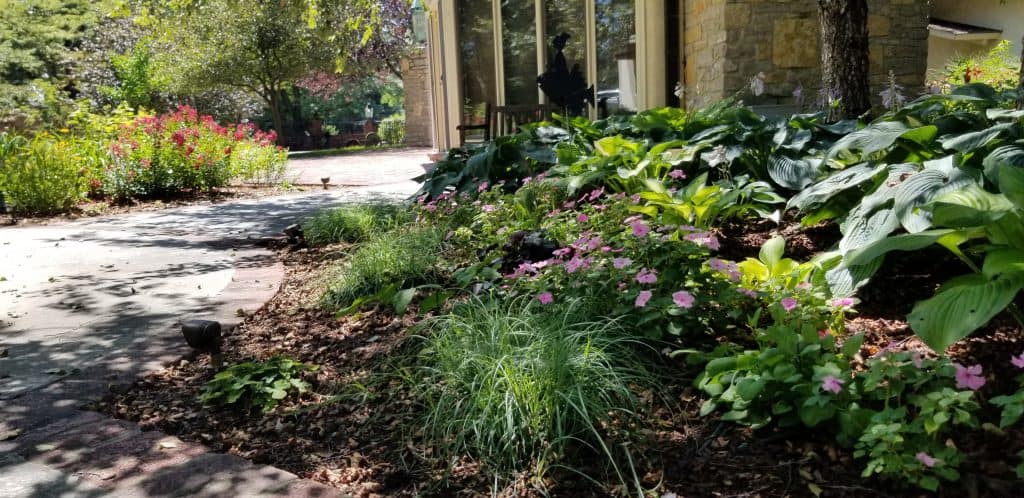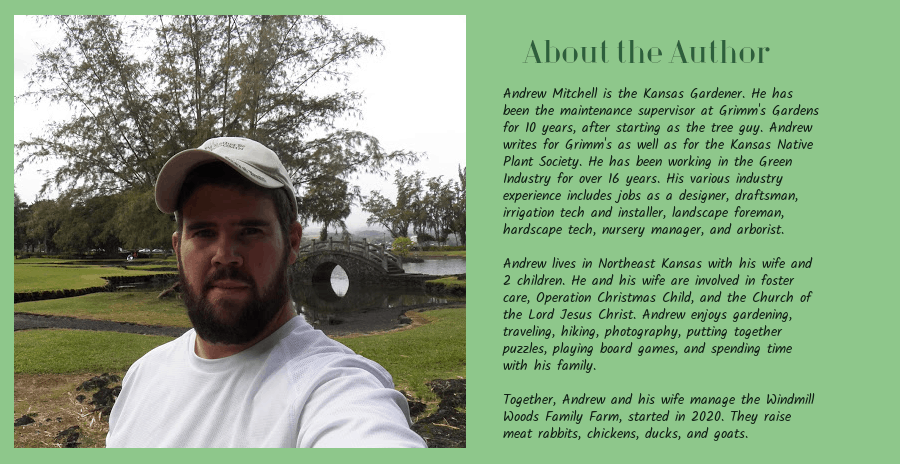Hostas are one of America’s favorite shade garden plants. We have seem to have a love of plants and shade, and so hostas fit right in. There are some 6100 registered hosta cultivars across the world. They originate from Northeast Asia, mainly from Japan, China, and Korea.
Being successful with hostas is a lot easier than many gardeners would think. They are one of the easiest plants to keep alive and grow, at least in hardiness zones 4 to 8. Here in the central Great Plains we have an abundance of weather that the hosta is quite adaptable to, even our hot summers.
I do not think that a shade garden, unless it is a strict woodland garden, is complete without hostas. They are so versatile and there are so many to choose from.
Cultivars of Hostas
Like I said above, there are around 6100 registered cultivars of hostas to choose from. However, most local nurseries (including Grimm’s Gardens), only carry about 15 to 20 cultivars each year, with some going away and new ones coming in each year. There are old favorites that are timeless (so it seems) and stay with a nursery for years.
Hostas have been bred and developed for a wide array of characteristics including leaf variegation, plant size, flower color and showiness, leaf texture, and much more than that. Knowing that we have so many to choose from, most of us longtime gardeners have our favorites. Me included.
Large Hostas
- Stained Glass – I do not know if I love the hosta more or the name of it. This cultivar has dark yellow leaves with green margins within. It grows 16 inches tall by 3 feet wide.
- Royal Standard – this is the oldest registered hosta cultivar. It is also one of the nicest green-leafed varieties you can grow. I have seen it spread very quickly to fill a space, from a division to full size – 2 feet tall by 2 feet wide – in less than 2 years. The flowers are also rather nice, very fragrant.
- Blue Mammoth – if you like large leafed hostas, this is one of the best. It grows 3 feet tall by 4 feet wide with deep blue-green leaves.
- Guacamole – even though I do not like guacamole, I really like this hosta. It has dark green leaves with a rich yellow center of the leaf. This hosta grows 2 feet tall by 3 feet wide and has nice flowers.
- Abiqua Drinking Gourd – this is perhaps the most interesting of all hosta cultivars. The large blue-green leaves are cupped upward much like the drinking gourd it is named for. It grows 2 feet tall and 3 to 4 feet wide.
- Empress Wu – one of the largest cultivars available, it fills a lot of space in a hurry. However, the roots take 2-3 years before the top can fill in the space. It grows 4 feet tall by 6 feet wide. Wow!
- Blue Umbrellas – another nice blue-green leafed variety that is on the large size. I was gifted a division of this when I first started shade gardening, and it quickly grew to its size of 3 feet tall and wide.

Smaller Hostas

- Dancing Queen – This is perhaps the best solid yellow or chartreuse leafed hosta. The color is stable and the plant is an award winner. It grows 18 inches tall and 3 feet wide.
- Patriot – this smaller cultivar is a standard in the landscape industry. It has green leaves with pure white edging. It grows about 16 inches tall and wide and is great for borders, containers, or mixing into the shade garden with other plants.
- Curly Fries – I really like leaves with wrinkled edges, and this one has that and chartreuse-yellow leaves. It grows to 10 inches tall by 16 inches wide.
- Autumn Frost – this is a nice small cultivar, growing 1 foot tall and 2 feet wide. The colors in the leaves are excellent, green edged with deep yellow, almost surreal in the landscape.
Other cultivars that can easily be found in nurseries
The following list contains cultivars that many nurseries carry. Newest cultivars from Proven Winners are also easy to find.
- Sum and Substance
- June
- Francee
- Blue Angel
- Big Daddy
- Praying Hands
- Waterslide
- Wheee!
- Rainbow’s End
- Lakeside Paisley Print
Planting and Dividing Hostas
Every year, it seems I am moving some hostas around for someone. Or planting them. But it is fairly easy work and I like doing it, for I like to see my client’s gardens filling up with plants.
Planting Hostas
When you are preparing to plant your hostas, there are different things to look for. I like to get a bareroot plant, one that does not have any soil on the roots at all. These are the easiest to plant, because you just dig a hole, make a mound in the center, and spread the roots out over the mound – then cover with soil. The crown of the plant (where the roots meet the leaves) should be just a 1/2 inch above the soil surface.
If planting a potted plant, the hole should be the size of the container to start. Gently remove the plant from the container by spreading your hand across the top with the leaves between your fingers and turning the container upside down. Holding it that way, loosen the root ball with your free hand and then put into the hole. Firm the soil around it.

Dividing Hostas
This is not necessary on all hostas, but can improve the look of the plant for the next season or help you get more hostas to spread around the landscape. I prefer to divide hostas in the fall, because the temperatures of the soil are warmer, and usually dry enough to dig.
Start by digging up the entire plant. Hostas grow similar to daylilies, with individual plants making up one large clump of plants. Wash or shake the soil off the roots gently, and then separate the individual plants from the clump. Replant just like planting a new bareroot plant.
Pests and Diseases of Hostas
While this list is not long, most hostas have some issues that need to be dealt with when trying to be successful. Despite these few trials, hostas are still very easy to grow.
Pests

Slugs & Snails
Slugs and snails are perhaps one of the biggest adversaries of the home gardener. These slimy arthropods like to hide most of the day, then come out at night to chomp on the hosta and other, unsuspecting plants. One of the best things you can do to lower the population of slugs and snails to a manageable level is to encourage small snakes in the garden.
This is done by allowing shrubs to grow all the way to the ground, and by leaving (if possible) small brush piles in the wooded edges or in hidden areas in the yard. Nurse trees and mulch piles also encourage small snakes.
Other methods of reducing damage done by slugs and snails is to have a child who likes to pick them up and play with them, then discard them into the chicken pen, as my son does.
Diatomaceous earth is also a good deterrent of them. If laid through the garden, under the leaves of hostas, it will rip the insides of these slimy creatures as they pass over it.
Beetles and Grasshoppers
In bad grasshopper years, I always have a problem with blister beetles. This is because the larvae of the blister beetle feeds on the larvae of grasshoppers. All while the adult beetles feed on my poor hostas! I usually start with handpicking (with gloves) these beetles off and dropping them into soapy water. It can be done at the same time as Japanese beetle collection on my hydrangeas.
But in the end, I usually resort to spraying my beloved hostas with a chemical, targeting the blister beetle. The chemical I use, bifenthrin, also kills the grasshopper, and any nearby Japanese beetles.
Rabbits and Deer

This meme is one that always makes me smile, and cringe at the same time. For I know too well what a single deer can do to a stand of lush hostas. In my own garden, I have had no problems with this marauding mammal, but rabbits do nibble my tender plants.
If you live in town, the likelihood of deer eating your hostas is probably minimal. But for those in the country, they could be a daily occurrence. However, the presence of a barking dog is usually enough to keep deer away. Fences work as long as they are either electric or high enough that the deer cannot jump or see over it.
Rabbits, however, are another problem entirely. Because of my large and diverse, landscape, I rarely get rabbit damage, even in early spring as they are first growing. But many people with smaller landscapes do have issues with Thumper.
Repellants of essential oils of citrus or lemongrass seem to work pretty well, but need to be reapplied every couple of weeks as rain washes most of the scent away. If you are able, a good, tight, fence of chicken wire or welded wire mesh smaller than 1 inch by 1nch around the perimeter of the landscape will keep them out. Be sure to bury the fence 8 inches into the ground to keep them from digging under it.
Diseases
There are but a few diseases that affect hostas, and one of them can be completely avoided just by buying certified nursery plants. Let me explain.
Hosta Virus X
This plant disease is a viral pathogen that causes discoloration, stippling, necrosis, and tissue damage. It does not kill the plant, but can cause it to look very ugly. Hosta virus X is sometimes confused with mutations or leaf sports, but is testable by a plant diagnostics lab. Some cultivars are more susceptible to having this disease than others.
Nurseries are not allowed to sell plants with hosta virus X, as there is no cure, so buying plants from a certified nursery is key to keeping your garden clean. Hosta virus X can be spread from one plant to another by pruners, shovels, spades, and other tools, when working in the garden.
Anthracnose
There are probably more gardeners with anthracnose on their hostas than most would believe. The symptoms of this fungal disease closely mimic scorch or sunscald. Usually found in the just the tips of the leaves, anthracnose causes white lesions with brown borders. The center of these spots usually dies and breaks away from the plant.
Treatment is just good cultural practices. Remove diseased leaves to a trash bin (DO NOT COMPOST) and maintain airflow (if possible) within the garden.
Sooty Mold
This fungal disease is most often caused by dripping honeydew from plant sucking insects in the trees above the hosta. The honeydew is high in sugar content, and sooty mold grows on the sweet substance. This is mostly aesthetic. No treatment is necessary.
Other Issues
Leaf Scorch
Leaf scorch is caused by improper placement of hostas where they receive to much direct sunlight. Or sunlight at the wrong time of day. Hostas prefer to grow in part shade (between 3 and 6 hours of sun per day). They should not be placed where they receive any late afternoon sunlight, as in the summer, the sun is brighter and hotter later in the day.
Hosta Companion Plants
If you have not read my post about Shade Gardening: Creation and Maintenance, then I suggest you do so. I will list a few plants here that grow well with hostas, but this is a short space, while that is a long space. Use the following plants near hostas to keep the shade garden looking tidy and full.
- Coral bells
- Foam flower
- Lenten rose
- Brunnera
- Bear’s breeches
- Bleeding hearts
- Japanese painted fern
- Autumn fern
- Woodland sedge

Conclusion
Remember, success with hostas really begins with YOU, the gardener. Plant them in part shade, no late afternoon sun, watch for slugs & snails. and protect them from rabbits.
Happy planting!




